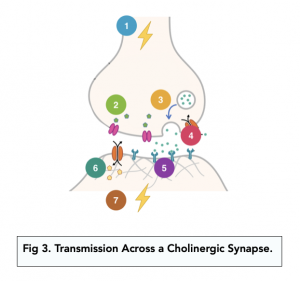Synaptic Transmission (A-level Biology)
Synaptic Transmission
Cholinergic Synapses
Transmission Across a Cholinergic Synapse
A cholinergic synapse is one that uses the neurotransmitter acetylcholine. You need to know the process of impulses passing across this type of synapse.
- Action potential arrives. When an action potential reaches the synaptic knob, the membrane of the pre-synaptic neurone changes permeability by opening voltage-dependent calcium channels.
- Calcium ions rush into the pre-synaptic neurone. Calcium ions diffuse into the synaptic knob down the concentration gradient.
- The synaptic vesicles fuse with the pre-synaptic membrane. The excess of calcium ions cause the vesicles to move towards and then fuse with the membrane, releasing acetylcholine (the contents of the vesicles) into the synaptic cleft. This process is exocytosis.
- Acetylcholine diffuses across the synaptic cleft. The neurotransmitters diffuse down the concentration gradient.
- Acetylcholine binds with receptors in the post-synaptic membrane. These receptors change shape, opening a channel to allow sodium ions to diffuse in. As the receptors are only present on the post-synaptic membrane, the impulse cannot travel back, so it is unidirectional.
- Sodium ions rush into the post-synaptic neurone. If enough sodium ions diffuse in, the action potential threshold is reached and this triggers depolarisation of the neurone.
- An action potential in the post-synaptic neurone is generated.

FAQs
Synaptic transmission is the process by which nerve impulses are transmitted from one neuron to another at a synapse.
Synaptic transmission works by the release of neurotransmitters from the presynaptic neuron, which then bind to receptors on the postsynaptic neuron and generate an electrical impulse.
Neurotransmitters are chemical messengers that play a crucial role in synaptic transmission by transmitting the electrical impulse from the presynaptic neuron to the postsynaptic neuron.
Neurotransmitters bind to receptors on the postsynaptic neuron through a process called ligand-gated ion channel activation. This activation allows ions to flow into the postsynaptic neuron, generating an electrical impulse.
Yes, different neurotransmitters can have different effects on the postsynaptic neuron, depending on the type of receptor they bind to and the type of ion channels they activate.
Synaptic transmission is the foundation of neural communication and information processing in the nervous system. By transmitting impulses from one neuron to another, it allows for the integration and processing of information in the brain.
Synaptic plasticity refers to the ability of synapses to change their strength and efficiency over time. It is related to synaptic transmission because it affects the amount of neurotransmitter released, the sensitivity of receptors, and the flow of ions in and out of the postsynaptic neuron.
Synaptic plasticity plays a key role in learning and memory by allowing the strength and efficiency of synapses to be modified through repeated use. This helps to encode and consolidate memories and improve information processing in the nervous system.
The synapse plays a critical role in transmitting information between neurons by allowing the electrical impulse from the presynaptic neuron to be transmitted to the postsynaptic neuron through the release of neurotransmitters.
Disruptions in synaptic transmission can impact brain function and behavior by altering the transmission of information in the nervous system. For example, diseases such as Alzheimer’s and Parkinson’s can affect synaptic transmission, leading to cognitive and motor impairments.





Still got a question? Leave a comment
Leave a comment